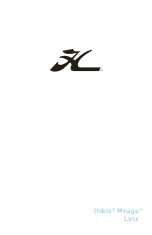
49
MONTEREY
BOATS
Helm Control Systems
are unique to the engines, drive system and other
options installed on your boat.
It is essential
that you read the owner’s manual for the
controls and be completely familiar with their
operation before using your boat.
CAUTION
ALWAYS RETURN THE ENGINE THROTTLE LEVERS TO THE
EXTREME LOW SPEED POSITION BEFORE SHIFTING. NEVER
SHIFT THE UNIT WHILE ENGINE SPEED IS ABOVE IDLE RPM.
Engine Synchronizing
During most operations of a twin engine boat, it is
advantageous for both engines to be operated at
the same RPM. This reduces noise and vibration
and can increase engine efficiency. Setting the
throttles so that the engines are running the same
RPM (synchronized) can be done by listening to
the engine sounds or with the synchronizer feature
built into the electronic engine controls. Attempt-
ing to synchronize the engines solely by using the
tachometer readings or control lever placement
generally will not work. When the engines are in
proper synchronization, the throttle levers may
not necessarily be even. Refer to the engine or
control owner’s manual for more information on
the using the engine synchronizer feature of your
control system.
4.3 Neutral Safety Switch
Every control system has a neutral safety switch.
This device prohibits the engines from being
started while the control lever is in any position
other than the neutral position. If the engine will
not start, slight movement of the control lever
may be necessary to locate the neutral position
and disengage the safety cutout switch. Control
system adjustments may be required to correct
this condition, should it persist. See your Mon-
terey dealer for necessary control adjustments.
Neutral safety switches should be tested periodi-
cally to ensure that they are operating properly.
To test the neutral safety switch, make sure the
outdrives are tilted down and move the control
levers to the forward position with the engines off.
Make sure the control levers and throttles
are set to the idle position.
Activate the starter
switch to engage the starter.
Notice:
Mercury DTS and volvo EVC systems are
equipped with a computer controlled start
feature that will keep the starter engaged
until the engine starts if the neutral safety
switch fails and allows the starter to engage.
The starter should not engage. Repeat this test
with the control levers in reverse and the engine
throttles at idle. Again, the starter should not en-
gage. If a starter engages with the control levers
in any position other than the neutral position,
then the neutral safety switch is not function-
ing properly and you should contact your dealer
to have the neutral safety switch repaired by a
qualified technician before using your boat. If the
engine starts in gear during this test, immediately
move the control levers to the neutral position and
turn the engine off.
WARNING
IN SOME SITUATIONS, IT MAY BE POSSIBLE TO
ACCIDENTALLY START THE ENGINE IN GEAR WITH THE
THROTTLE ABOVE IDLE IF THE NEUTRAL SAFETY SWITCH IS
NOT OPERATING PROPERLY. THIS WILL CAUSE THE BOAT TO
ACCELERATE UNEXPECTEDLY IN FORWARD OR REVERSE
AND COULD RESULT IN LOSS OF CONTROL, DAMAGE TO
THE BOAT, OR INJURY TO PASSENGERS. ALWAYS TEST THE
NEUTRAL SAFETY SWITCH PERIODICALLY AND CORRECT
ANY PROBLEMS BEFORE USING THE BOAT.
4.4 Outdrive Power Tilt and Trim
All inboard/outboard drive systems have a tilt and
trim feature for the outdrives. This allows the
operator to control the position of each outdrive
from the helm. Moving the outdrive closer to the
boat transom is called trimming “in” or “down.”
Moving the outdrive further away from the boat
transom is called trimming “out” or “up.” In most
cases, the boat will run best with the drive unit
adjusted so the hull runs at a 3 to 5 degree angle
to the water.
Typically, a switch or switches on the control lever
grip activates the tilt/trim. On twin engine boats,
there are typically three switches. One switch that
activates both outdrives simultaneously on the
port control lever and two switches, one for each
outdrive, that activates each tilt/trim individually.
The individual tilt/trim switches are usually located
either on the port control lever or on a keypad on
the control housing.
Summary of Contents for 378SE
Page 1: ......
Page 2: ...2 MONTEREY BOATS...
Page 4: ...4 MONTEREY BOATS NOTES...
Page 27: ...27 MONTEREY BOATS Operation...
Page 38: ...38 MONTEREY BOATS NOTES...
Page 56: ...56 MONTEREY BOATS NOTES...
Page 62: ...62 MONTEREY BOATS NOTES...
Page 88: ...88 MONTEREY BOATS NOTES...
Page 128: ...128 MONTEREY BOATS NOTES...
Page 138: ...138 MONTEREY BOATS NOTES...
Page 152: ...152 MONTEREY BOATS NOTES...
Page 159: ...159 MONTEREY BOATS Appendix A Hours Date Dealer Service Repairs Maintenance Log...
Page 160: ...160 MONTEREY BOATS Maintenance Log Hours Date Dealer Service Repairs...
Page 161: ...161 MONTEREY BOATS Maintenance Log Hours Date Dealer Service Repairs...
Page 162: ...162 MONTEREY BOATS Maintenance Log Hours Date Dealer Service Repairs...
Page 164: ...164 MONTEREY BOATS NOTES...
Page 165: ...165 MONTEREY BOATS Boating Accident Report Appendix C...
Page 166: ...166 MONTEREY BOATS Boating Accident Report...
Page 167: ...167 MONTEREY BOATS Boating Accident Report...
Page 168: ...168 MONTEREY BOATS NOTES...
Page 174: ...174 MONTEREY BOATS CAUSE AND SOLUTION NOTES...
Page 182: ...182 MONTEREY BOATS NOTES...
Page 184: ...184 MONTEREY BOATS Schematics Sureshade Harness SP SC 115 CONDUIT...
Page 192: ...192 MONTEREY BOATS Schematics 12V Engine Hatch Harness...
Page 198: ...198 MONTEREY BOATS Schematics 120V Hull Harness 54 24 24 30 6 6 6 6 48 MDP3 MDP4 88...
Page 200: ...200 MONTEREY BOATS NOTES...
Page 202: ...202 MONTEREY BOATS NOTES...
Page 208: ......
Page 209: ......
Page 210: ......
















































